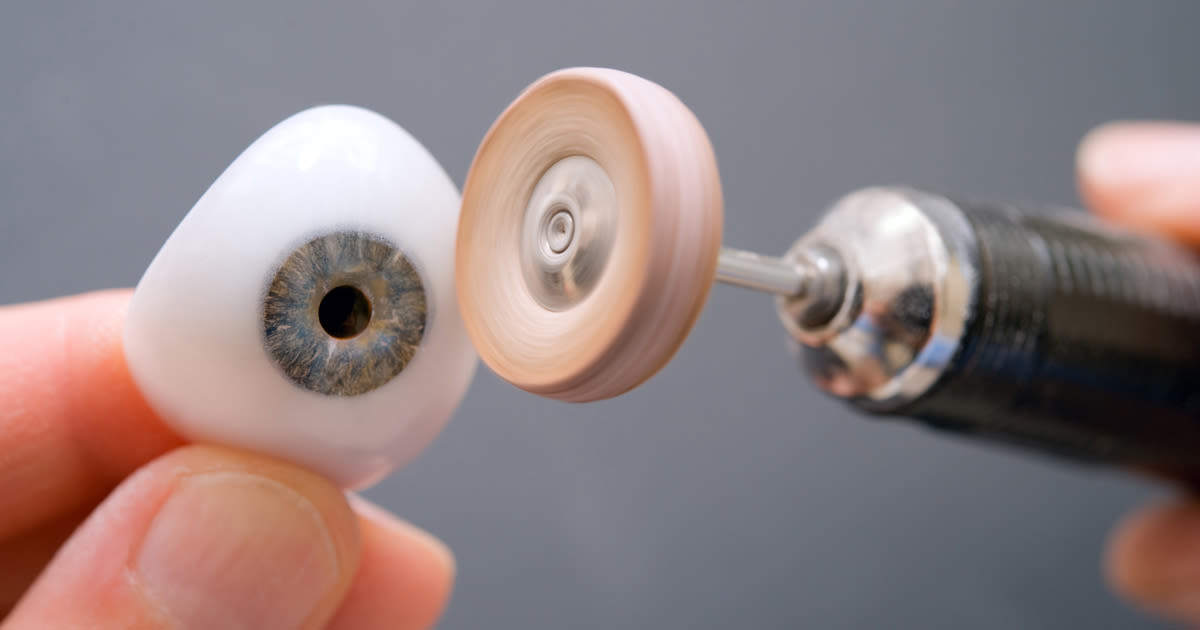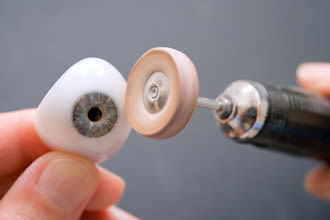Losing an eye: Enucleation and prosthetic eye FAQs

Enucleation is the surgical removal of an irreparably damaged or severely diseased eye. Conditions that make enucleation necessary include:
Severe eye trauma
Eye cancer
Serious eye diseases and infection
Once the affected eye is removed, the person undergoing the enucleation procedure typically is fitted with a custom-made prosthetic eye (also called an artificial eye, glass eye, or ocular prosthesis).
Although a prosthetic eye cannot restore vision, it can provide a more natural appearance.
Modern prosthetic eyes are custom-made and matched in size and colour to the remaining natural eye in such detail that it's often difficult for others to notice that a person is "wearing" a glass eye.
Here are answers to frequently asked questions about surgical eye removal and the manufacture, fitting and care of prosthetic eyes.
What is enucleation?
Enucleation is surgical removal of an entire eye. The muscles that were attached to the outside of the eyeball to control its movement and other tissues that surrounded the eye within the bony socket of the skull are left intact.
These muscles are attached to a round (marble-like) implant that replaces the tissue volume lost when the eye is removed. Attaching them to the implant offers the patient some movement of the artificial eye after surgery.
When is enucleation necessary?
The most common reasons for surgical removal of an eye include: eye cancers (for example: choroidal melanoma; retinoblastoma); trauma; uncontrollable infection; end-stage glaucoma; or any condition that causes ongoing, unmanageable eye pain in a blind eye.
Also, unsightly blind eyes frequently are removed in order to rehabilitate the eye socket and offer the patient a better cosmetic alternative.
What can I expect immediately after enucleation surgery?
Enucleation surgery typically is performed under general anesthesia, so you won't feel any discomfort during the procedure. Local anesthesia is often applied at the end of the surgery so you will experience little or no discomfort when you wake up in the recovery room afterward.
A small plastic conformer that resembles half an almond shell is placed behind the eyelids to maintain their shape after surgery. Occasionally, a single stitch is placed in the eyelids to temporarily sew them together for a few days.
The conformer serves as a placeholder for the artificial eye that is fitted several weeks later, after swelling has subsided and sufficient healing has taken place.
It's common to have a headache the first day or two after surgery, but this typically can be managed with over-the-counter pain relievers. Occasionally, a prescription pain medication may be required.
Some patients may need medicine for nausea, which usually lasts only a day or two.
A pressure patch will be applied immediately after enucleation surgery. Some surgeons allow the patch to be removed on the day after surgery and replaced daily by the patient while others may require the patch to be left in place for a few days.
You may be given oral antibiotics and steroids to take until your follow-up visit four to six days later.
At your first follow-up visit, your surgeon or eye care professional will remove your patch and examine the surgical wound. If everything is healing properly, you will be given topical antibiotic drops or ointment to apply to the area several times daily for a couple of weeks.
How is an ocular prosthesis created?
Once your surgeon thinks your eye socket is ready for a glass eye (approximately 3-6 weeks after surgery), you will be referred to an ocularist. An ocularist is a professional who specialises in custom-crafting artificial eyes.
At your first visit with the ocularist, the creation of a prosthetic eye that matches the appearance of your functioning eye will begin.
When it's time to insert the prosthetic eye, the conformer is removed. Like the conformer, the glass eye is shaped like a curved shell that fits behind the eyelids and in front of the implant.
The eye socket can change in shape over time, so adjustments and refitting of a glass eye may be needed as time goes on. Typically, prosthetic eyes require yearly polishing by the ocularist and replacement every five to seven years.
Recently, researchers in Belgium reported the development of a new method for producing an ocular prosthesis using computer-aided design and manufacturing. An artificial eye — created using a three-dimensional (3D) printed, impression-free mold of the eye socket — was successfully fitted for a 68-year-old male.
The researchers believe this is the first case of a customised ocular prosthesis designed with the aid of 3D printing, which eliminates the need for impression molding and may result in even greater consistency in the creation of well-fitting, natural-appearing artificial eyes in the future.
Are all glass eyes made of glass?
No. A prosthetic eye can be made of a number of materials that are compatible with the eye socket tissues.
The most common material used to create a glass eye is an acrylic plastic polymer called polymethyl methacrylate (PMMA), which is used for a number of applications when a lightweight, shatter-resistant alternative to glass is desired. Also known as acrylic or acrylic glass, trade names for PMMA include Plexiglas and Lucite.
Silicone polymers also are used to make artificial eyes.
Can a prosthetic eye move like a normal eye?
In most cases, yes. It depends on the surgical techniques and materials used for the ocular prosthesis. People often are able to follow moving objects with an artificial eye in unison with the movements of their functional eye.
The pupil size of a glass eye, however, is constant and will not change in response to lighting conditions. So the pupils of the two eyes (one real and one artificial) won't always match perfectly. But a high-quality prosthesis combined with newer implants can create a very natural appearance.
Additional cosmetic procedures on the eyelids and other structures surrounding the prosthetic eye also can enhance the final outcome.
Also, a fashionable pair of glasses with impact-resistant lenses can help prevent most onlookers from noticing that a person has a glass eye.
Can I wear contact lenses (on my seeing eye) after enucleation surgery?
Anyone who undergoes enucleation and wears a glass eye should purchase glasses with impact-resistant polycarbonate lenses and wear these glasses at all times after surgery to protect his or her functional (seeing) eye.
Even a seemingly harmless minor eye injury, like a mild corneal abrasion, can be a serious problem for a person with only one functioning eye, and even the best-fitting and properly worn contact lenses increase the risk of an eye infection that could have devastating consequences.
Adjusting to life with a prosthetic eye
Losing an eye, undergoing enucleation surgery, and being fitted with a glass eye can be an emotionally traumatic experience, requiring a significant psychological (as well as physical) healing period. For this reason, counselling and support groups can be a great help during a patient's recovery.
With the help of a talented surgeon, the latest implant technology, a skilled ocularist, and caring support from family, friends and professionals, a person who has lost an eye can regain his or her appearance and feel very good about what lies ahead.
FIND AN OPTICIAN: if you're concerned about your vision, visit an optician near you.
Page published on Monday, 14 March 2022







